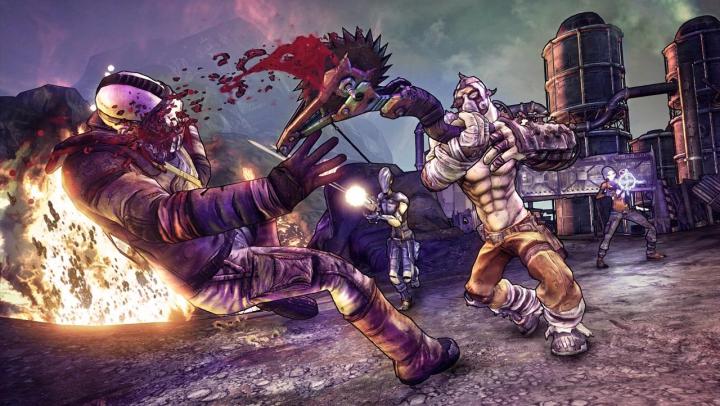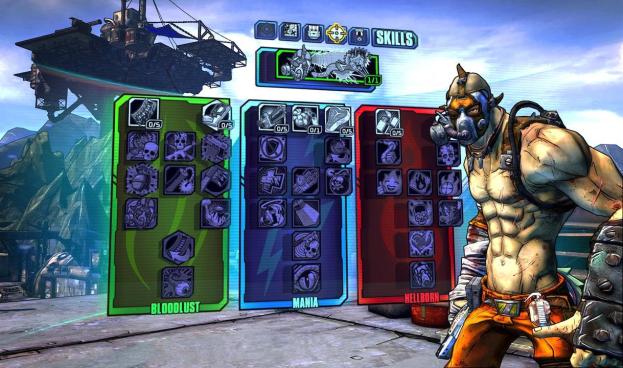
Borderlands 2 is built to reward investment. The Legendary and Pearlescent weapons, the high-level “capstone” abilities that sit at the top of each skill tree, the raid boss system… all of this exists with an eye toward giving a player on hour 100+ something to do. Gearbox Software’s two downloadable characters, Gaige the Mechromancer and Krieg the Psycho, serve the same purpose. There’s an assumption you’re already invested by the time you pick one up. They both require an attentiveness to ability usage that you adapt to only after you’ve played as a high-level character from the vanilla game.
“You have to take advantage of your knowledge of the game as it exists,” franchise director Matt Armstrong tells Digital Trends. “It’s almost like a roguelike. The first time you play a game like FTL or The Binding of Isaac or something, you just die. You have to play it several times before you start to understand the rules and excel. With Borderlands, we can’t let the player just die and have a miserable time the first time. If we had included Krieg or Gaige when the game shipped, players would have that experience.”
Differing design sensibilities led to the creation of Gaige and Krieg, but the two DLCs are linked by this underlying idea that anyone spending cash on a new character is already invested enough in Borderlands 2 to handle something a bit less traditional and a bit more technical. It’s not just about prolonging enjoyment for the dedicated fan; there’s also a more deeply ingrained philosophy of delivering a product that gets people talking.

“The thing about building the DLC characters is, we can push on a principal that is really critical to Borderlands, and that principal is polarization,” Gaige creator and Borderlands 2 lead character designer John Hemingway explains. “A lot of things in Borderlands, we build them [knowing that] some people are going to love this and some people are going to hate this. The classes are that way, the guns are that way. Everyone has their own preferences. That goes into the characters and that goes into the skills as well.”
Krieg creator and Borderlands 2 creative director Paul Hellquist agrees. “[We love] that debate and discussion about ‘Here’s why it’s the worst!’ and then the next guy saying, ‘Here’s why it’s the best!’ It’s usually [because they’re] using these kinds of gear and this kind of playstyle. They have different points of view on the game. We love that we’re able to supply the rewarding experience for both of those people.”
“A lot of things in Borderlands, we build them [knowing that] some people are going to love this and some people are going to hate this.”
Once you’ve got your Action skill unlocked, you’re able to access three skill trees that you can start assigning points to. Each tree tends to favor one style of play or another. Take Salvador: you’ve got Gunlust for beefing up your firearms, Rampage for mastering the sacred art of gunzerking, and Brawn for being your group’s bullet sponge. Most skills in a tree enhance various attributes, but unique mid-tier Gamechanger and top-tier Capstone skills offer additional flexibility in how you approach play with a particular character.
The development of an add-on character starts with the Action skill, since that’s the defining characteristic. Capstones and Gamechangers are added from there, and the rest of the skills – largely filled out by stat modifiers – follow after that. “They’re usually themed around gameplay concepts,” Armstrong says of the approach to fleshing out each skill tree. “This one’s all about close-quarters and high-risk, this one’s long-range support, this one’s all about buffing your robot or making life easier for the new player.”

As the first DLC character, and one that arrived fairly soon after the release of Borderlands 2, there was a bit of a dual focus in building what Gaige could do. On the one hand, her Ordered Chaos tree introduced the entirely new concept of generating a resource called Anarchy, either by killing an enemy or fully emptying a weapon’s clip. As the Anarchy count rises, Gaige deals more damage but fires her weapons with less accuracy.
“For awhile I had [the Ordered Chaos tree] named TANSTAAFL, which stands for ‘There Ain’t No Such Thing As A Free Lunch,'” Hemingway says. “Because originally, every single skill in the tree had a positive and a negative. So Anarchy was the first skill there, and then, as we started playing with that, we realized that the real heart of this tree is about anarchy. As you continue [earning Anarchy stacks], your damage increases and your accuracy goes down. You’re embracing chaos. That name really came out of the evolution of us refining our understanding of what the real gameplay of that tree was.”
“You’re embracing chaos. That name really came out of the evolution of us refining our understanding of what the real gameplay of that tree was.”
“One of our missions with Gaige… was we wanted her to also be a character that people who have never played a shooter before could have a place where they could grow their character and have that co-op experience with their more experienced friends or relatives,” Hellquist explains. “I think she was really interesting in that way because she had to be at the farthest ends of the spectrum.”
Krieg was a very different proposition. Released eight months after the September 2012 launch of Borderlands 2, the second add-on character was born from the start out of a promise: play as that crazy dude in the box art. Psychos are one of Pandora’s more common enemy types. Krieg is simply a Psycho who, for whatever reason, decided to go Vault Hunter. His skill trees allow players to tailor his development toward some of the many Psycho variants that are encountered as enemies, while his Action skill is all about moving fast and beating the crap out of people with a buzzsaw axe… just like a Psycho would.

“Krieg was building off the [Mechromancer’s Ordered Chaos] tree. We saw how interesting and new and fresh that [Anarchy stuff was] for changing up gameplay,” Hellquist explains. One of Krieg’s trees involves generating a resource that isn’t too far removed from Anarchy, but all three of his trees share a focus on technical play. “If you don’t understand and figure out how these trees work, you’re probably just going to be terrible. It was… very much for the guys who are still playing the game eight months after release and have multiple characters at max and are looking for a new way of thinking and playing the game.”
Hellquist liked the idea of changing up the gameplay, but more than that, he was jazzed about creating a character with a skillset that turns negatives into a positives. This ties back to Gearbox’s emphasis on fostering discussion through design. Krieg’s three skill trees are balanced in a love-it-or-hate-it sort of way, with the character’s most powerful tools only accessible when damage has been sustained. And high-risk/high-reward play tends to be divisive.
“We really like it when somebody grabs a gun or gear that is inherently negative, and finds a way to turn it into a positive,” Armstrong says. “I’m on fire. That’s a terrible thing normally, but can we make that a positive thing? Which is… such a strange and radical concept.” Strange? Yes. Radical? Sure thing. It works though. Dig into Krieg’s Hellborn tree, and you find all manner of new and interesting ways to amp up your abilities by lighting yourself on fire. Build onto the Mania tree and Krieg will inflict damage on himself, but in doing so he also becomes a more effective melee fighter.

Consider again the idea that Borderlands 2 is built to reward investment and you start to see how its design informed the development of both Gaige and Krieg. These characters are rewards for time well spent; you might even call them overpowered, provided that certain skills have been built out and a knowledgeable player is at the controls. They never would have fit in alongside the vanilla foursome of Axton, Maya, Salvador, and Zer0.
“It’s really difficult for you to do something that tricky and advanced in the main game,” Armstrong says. “We couldn’t ship with [Gaige’s] Anarchy tree; the Anarchy tree radically changes how the game plays. If a new player who’s never played the game buys it, picks Gaige, goes down the Anarchy tree, and then has a miserable experience because they’ve never played the game before, that’s really bad. It’s very risky for you to do things that radical or unusual in the release game. So DLC gave us an opportunity to make more interesting or, if you spec them right, really overpowered or different kinds of characters.”
We recently paid a visit to Gearbox Software’s Texas home base for an up-close look at the team’s approach and creative process for DLC. Stay tuned for plenty more exclusive Borderlands 2 content this week, including deep dive looks at how the team assembles both add-on story content and new characters. And if you’re headed to PAX Prime, be sure to visit the 2K booth if you want an early hands-on shot at taking on the Pumpkin Kingpin.
Check out the first article from our Gearbox tour, Upcoming ‘Borderlands 2′ DLC powers you up and sends you hunting for heads, then read about the studio’s development process for story DLC in Pirates, ninjas, and robots: Expanding ‘Borderlands’ $10 at a time.
Editors' Recommendations
- Hyper Light Breaker publisher has new name after Gearbox shake-up
- Embracer Group finally sells Gearbox Software, but keeps Gearbox Publishing
- How to unlock the Invader in Remnant 2
- Counter-Strike 2 limited test: how to play, game modes, and more
- WWE 2K23 improves the wrestling sim with subtle tweaks and a bit of chaos


